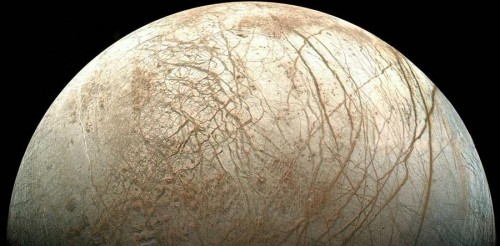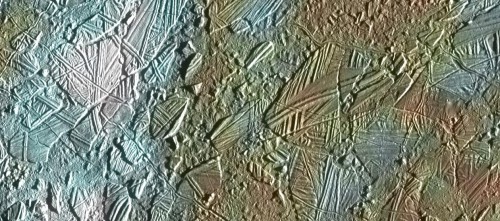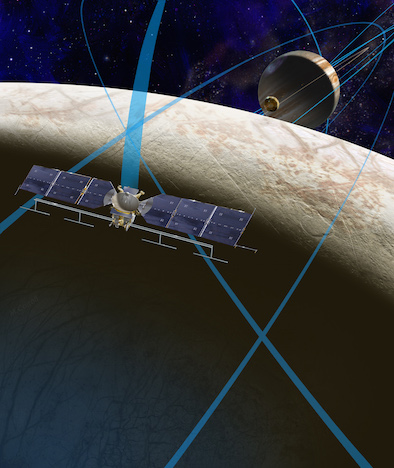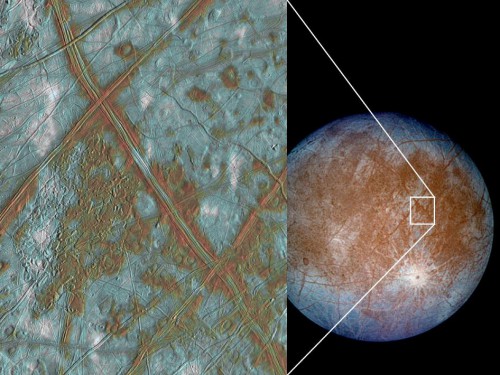
An exciting new development in planetary exploration was announced today: NASA has chosen the science instruments which will be included in a new mission to Jupiter’s moon Europa. For those advocating and supporting such a mission, this is welcome news indeed. Europa’s subsurface ocean has become a prime target in the search for possible life elsewhere in the Solar System, and this mission may finally help to answer long-standing questions about this fascinating moon.
“Europa has tantalized us with its enigmatic icy surface and evidence of a vast ocean, following the amazing data from 11 flybys of the Galileo spacecraft over a decade ago and recent Hubble observations suggesting plumes of water shooting out from the moon,” said John Grunsfeld, associate administrator for NASA’s Science Mission Directorate in Washington. “We’re excited about the potential of this new mission and these instruments to unravel the mysteries of Europa in our quest to find evidence of life beyond Earth.”

The science instruments will provide for an unprecedented study of Europa and its potential habitability; underneath the ice crust is a global ocean of liquid water thought to be similar in composition to Earth’s oceans. Along with a rocky sea floor and energy and chemistry from tidal heating, thanks to Jupiter, Europa is a fascinating world which may be quite habitable by Earthly standards.
Europa Clipper, as it is tentatively being called, is a solar-powered spacecraft which will orbit Jupiter, but make 45 close flybys of Europa over three years, at altitudes ranging from 16 miles to 1,700 miles (25 kilometers to 2,700 kilometers). The instrument payload includes high-resolution cameras and spectrometers, ice-penetrating radar, and a magnetometer. The spacecraft will also look for the elusive plumes of water vapor first tentatively seen by the Hubble Space Telescope in 2012. The brownish “smudges” on Europa’s surface are another prime target of study, as they are thought to be places where water from below has reached the surface through the many cracks in the ice shell, depositing minerals or other material. Regions of “chaotic terrain,” where the ice has been broken and jumbled like pieces of a jigsaw puzzle, are also thought to likely be directly over subsurface hydrothermal vents on the ocean floor. Such vents in Earth’s oceans are oases of a wide variety of life forms.
The mission could launch as early as 2022, or at least in the early-mid 2020s.
Out of 33 proposals, nine were selected to fly aboard the mission. They are:

Plasma Instrument for Magnetic Sounding (PIMS) — principal investigator Dr. Joseph Westlake of Johns Hopkins Applied Physics Laboratory (APL), Laurel, Md. This instrument works in conjunction with a magnetometer and is key to determining Europa’s ice shell thickness, ocean depth, and salinity by correcting the magnetic induction signal for plasma currents around Europa.
Interior Characterization of Europa using Magnetometry (ICEMAG) — principal investigator Dr. Carol Raymond of NASA’s Jet Propulsion Laboratory (JPL), Pasadena, Calif. This magnetometer will measure the magnetic field near Europa and, in conjunction with the PIMS instrument, infer the location, thickness and salinity of Europa’s subsurface ocean using multi-frequency electromagnetic sounding.
Mapping Imaging Spectrometer for Europa (MISE) — principal investigator Dr. Diana Blaney of JPL. This instrument will probe the composition of Europa, identifying and mapping the distributions of organics, salts, acid hydrates, water ice phases, and other materials to determine the habitability of Europa’s ocean.
Europa Imaging System (EIS) — principal investigator Dr. Elizabeth Turtle of APL. The wide and narrow angle cameras on this instrument will map most of Europa at 50 meter (164 foot) resolution, and will provide images of areas of Europa’s surface at up to 100 times higher resolution.
Radar for Europa Assessment and Sounding: Ocean to Near-surface (REASON) — principal investigator Dr. Donald Blankenship of the University of Texas, Austin. This dual-frequency ice penetrating radar instrument is designed to characterize and sound Europa’s icy crust from the near-surface to the ocean, revealing the hidden structure of Europa’s ice shell and potential water within.
Europa Thermal Emission Imaging System (E-THEMIS) — principal investigator Dr. Philip Christensen of Arizona State University, Tempe. This “heat detector” will provide high spatial resolution, multi-spectral thermal imaging of Europa to help detect active sites, such as potential vents erupting plumes of water into space.
MAss SPectrometer for Planetary EXploration/Europa (MASPEX) — principal investigator Dr. Jack (Hunter) Waite of the Southwest Research Institute (SwRI), San Antonio. This instrument will determine the composition of the surface and subsurface ocean by measuring Europa’s extremely tenuous atmosphere and any surface material ejected into space.

Ultraviolet Spectrograph/Europa (UVS) — principal investigator Dr. Kurt Retherford of SwRI. This instrument will adopt the same technique used by the Hubble Space Telescope to detect the likely presence of water plumes erupting from Europa’s surface. UVS will be able to detect small plumes and will provide valuable data about the composition and dynamics of the moon’s rarefied atmosphere.
SUrface Dust Mass Analyzer (SUDA) — principal investigator Dr. Sascha Kempf of the University of Colorado, Boulder. This instrument will measure the composition of small, solid particles ejected from Europa, providing the opportunity to directly sample the surface and potential plumes on low-altitude flybys.
As Curt Niebur, Europa program scientist at NASA Headquarters in Washington, noted: “This is a giant step in our search for oases that could support life in our own celestial backyard. We’re confident that this versatile set of science instruments will produce exciting discoveries on a much-anticipated mission.”
In addition, the SPace Environmental and Composition Investigation near the Europan Surface (SPECIES) instrument has also been chosen for further technology development. SPECIES is a combined neutral mass spectrometer and gas chromatograph which will be developed for other mission opportunities.
While not specifically a life-detection mission, Europa Clipper will help to answer many of the big questions in terms of the habitability of this ocean moon, and there is the potential for discovering evidence which could be indicative of biological processes, as noted in the press briefing. Europa is also just one of several moons in the outer Solar System now known or thought to have subsurface oceans. If even just one of them has become a home for life of some kind, it would be an extraordinary discovery, one that would suggest that biology is common in the universe, even if in many or most cases, it was simple microorganisms. As the search continues, water worlds like Europa would seem to be some of the most likely places to find it.
Want to keep up-to-date with all things space? Be sure to “Like” AmericaSpace on Facebook and follow us on Twitter: @AmericaSpace




All things considered, this is a nice instrument mix for the first dedicated (and long overdue) mission to Europa. All we need now is a launch date and a long term commitment from Congress to fund this mission all the way through!
It is disappointing that NASA again doesn’t seem to be listening to congressional appropriators, specifically the CJS Apropos Subcommittee Chair, Rep. Culberson, who has already said he wants, and is putting-in funding for, a lander that will have the ability to actually explore the Europan oceans.
This repeated inability of NASA’s senior leadership to listen and then, most critically, follow congressional will, only raises the support for reforming NASA’s management and how its budget is created within those Subcommittees with NASA oversight.
A lander to explore the oceans? Really??? The technology to get a lander on the surface certainly exists (it would be expensive and add a lot of mass to the mission), but we simply do not have the proven technology available to penetrate tens of kilometers of ice to a Europan ocean below with any sort of proven autonomous system (we can barely penetrate kilometers of ice with fully crewed rigs in the Antarctic)… not within any conceivable budget for this program and certainly not available in the next decade or so.
According to Casey Dreier of the Planetary Society, the House CJS Apropos Subcommittee voted to appropriate in FY16 $140M, at $110M that’s 467% more than the Administration requested, for the Europa mission. Also approved was that the Europa mission would be launched on an SLS. If the Europa mission launches in 2022, the SLS carrying it will have the Exploration Upper Stage (EUS).
SLS program head Todd May said at last year’s AAS Von Braun Symposium that the first gen SLS, which uses the Interim Cryogenic Unit (ICU) will be able to launch 80-85mT. The next EUS will grow the SLS’s launch mass by 20 mT, to 100 mT.
So, the question isn’t if the payload can fit into the rocket–the days of worrying about that are thankfully drawing to an end by 2018, at least for awhile. The question is can the probe be built and launched in 6 years. Culberson has said that he will support a soft (5mph) lander for Europa. With $100M appropriated this year and $140M for next, he seems serious about this. Oddly, NASA does not seem to be leaning towards a soft lander with this announcement.
quest’s points are the same solutions for getting through Europa’s ice as explored by a team at U. Texas while I was doing my aerospace graduate work there.
I’m going to prognosticate and predict that NASA and Culberson are going to lock horns on Europa and NASA will loose. But that loss will be very good for all of us.
I have two points to make: First, having a concept to penetrate the ice on Europa that has had limited field testing is not the same as having flight hardware ready to fly a space mission to a largely unknown environment like the surface of Europa and below. Developing this technology will take time (which could delay this long-awaited flight by years) and money (which will escalate the billion-ish dollar budget of this program by a fair amount).
Second, considering that Congressional support for this mission is by no means guaranteed for the several years it is already going to take to develop and build this fairly modest spacecraft, adding an additional risky and expensive element to this mission like a lander (or worse yet, a means of penetrating the ice) that will likely push back the already nebulous early-2020s launch date even further into the future will only increase the chances of this mission being cancelled by budget conscious Congress. It is better to get this mission off the ground as quickly as possible while it still has a modicum of support in Congress and give it as little reason as possible to be a target of future budget cuts.
Looking at the incredibly long amount of time it took to get what would become New Horizons proposed, approved, built and of the ground, I think it is far wiser to launch this more modest mission to Europa first. The vital data this looooooong-delayed mission will return will be instrumental in designing more daring follow up missions with lower risks and less cost. That is just the opinion of one looooooong-time observer of the US space program 🙂
It’s always a pleasure to read your posts Jim, they’re always very well-written, directly on point, well-researched, and obviously the product of extensive knowledge of the subject. AmericaSpace has always been THE site for intelligent, logical aerospace and astronomy discourse without cheer-leading or cult-of-personality fawning. AmericaSpace presents the facts. If one does not like the facts, there are plenty of other sites where one can make them up and believe whatever one wishes – if it is repeated often enough, it becomes accepted as true.
> With $100M appropriated this year and $140M for next, he seems serious about this.
> Oddly, NASA does not seem to be leaning towards a soft lander
Oddly?
There must be some sort of disconnect or misunderstanding here, a soft lander for Europa would run into the multi *BILLION* dollar range. A soft lander + the orbiter to deliver it and relay data back, would fall into the “flagship” mission status. Really, Flagship on steroids when you factor in the RTGs for lander & orbiter, military grade rad-hard electronics, terrain avoidance and precision landing system for the lander, and on and on.
This is certainly one method that could be employed to get through Europa’s icy crust but it will take time as well as money (read LOTS of money) to develop the required technology and get it to the needed level of maturity to attempt such a mission. For example, it has been 50 years since the US has even sent a nuclear reactor into space.
http://www.drewexmachina.com/2015/04/03/50-years-ago-today-the-first-nuclear-reactor-in-orbit/
In the mean time, the currently proposed mission will provide vital data (e.g. the thickness and properties of Europa’s icy crust) needed to properly design such an ambitious mission and the required hardware.
I also noted, via Sarah Horst, that the instrument which could detect chirality, i.e. evidence for life itself, wasn’t selected. And I want a lander too! But overall, still exciting of course.
The one thing that a half a century of searching for life on Mars has proven is that searching for unambiguous signs of life on another world is no where near as easy as we thought it would be. Any attempt to look for alien life on Europa given how little we know about this world would have been a waste of valuable payload space at this early stage. Better to use the available space for more basic instruments to characterize this world and save the tougher task for a follow up mission. *IF* the proposed SUDA (SUrface Dust Mass Analyzer) instrument detects evidence of plumes/dust in sufficient quantities, an inexpensive follow up mission to return dust samples using aerogel collector technology like that used on NASA’s Stardust mission (as proposed for the LIFE sample return mission to Enceladus) might provide samples to search for life on Europa using infinitely better equipped laboratories here on Earth.
http://www.drewexmachina.com/2014/03/27/a-europa-io-sample-return-mission/
Andrew, stop redirecting our readers to your website, we offer advertising space for that, you do it too often and such links will be removed moving forward.
Apologies, Mike. In my zeal to share information of potential interest with my fellow readers, I sometimes lose sight of the fact that while the web is just a “hobby” to me, it is a business to others. It will not happen again.
Any design for a Europa landing mission will require more knowledge of the surface ice, ice thickness, and the water depth. This mission should be able to provide that. I would like to see a Europa orbiter mission, but this mission seems to be a compromise to get as much scientific payload to Jupiter orbit where it can do other science in the Jupiter system.
Hooray! At least someone in Congress is listening and supporting a mission to Europa. Culbertson understands the significance of the the science gleaned from such exploration and hopefully will continue to support other missions to the Jupiter/Saturn moon systems. As for a “lander,” why not consider a Huygens-type probe to drop on Europa, taking pictures and gathering other scientific data as it descends to the surface? It would be a start.
It gives one pause for thought that we have a FY 2016 appropriation of 140 million for a Europa mission (thanks to Rep. Culberson who probably remembers how it required the threat of subpenas to stop the Administration from “slow-balling” the SLS after the “Orion lifeboat joke)but although we no doubt have the geniuses in the rank-and-file of NASA to create an excellent lander, we need worry about future funding. I know there are those who wish that New Horizons had a lander, but “sorry, there’s no money”. The total bill for Iraq so far is what, three TRILLION, and the fresh slaughter of 400 government workers captured in Ramadi by sub-human ISIS psychotics shows that was money well spent. The money spent to clean up that God-forsaken litter box was bad enough, but far worse is how crushingly demoralizing it must surely be for parents, wives, husbands, and children who sacrificed their Dearest loved ones, and the incredibly heroic individuals who left blood, limbs, friends, and peace of mind in that maggot-ridden dung heap. Yeah, no doubt some future administration will probably cut funding for the Ocean Worlds Exploration Program, so we can make Afghanistan into a Jeffersonian democracy too.
Spare everyone the inappropriate rants about defense spending and politics.
Spending on space science is part of the discretionary budget, space enthusiasts would do well to put funding in context. Instrument development for this Europa mission will add up to ~$100 million dollars before the final mission systems design is even approved. My friends and colleagues in the biological and life sciences are livid when they see numbers like that, one hundred million dollars would fund a legion of grad students in molecular biology, or pay for a new research wing with state-of-the-art laboratories at the University.
Count your blessings.
Gee, what a big surprise, yet another off-topic inappropriate whine about not enough tax dollars being slopped into the trough for his professional grant-grabbing friends and colleagues, causing them to be “livid”. Surely there are molecular biology sites more sympathetic to your “pity poor under-funded us” ravings. With Rep. Culberson pushing for the Ocean Planet Exploration Program, and a Europa lander, prepare for more livid biologist friends, that is, until they start applying for grants to study the results of the Europa mission.
“pay for a new research wing with state-of-the-art laboratories at the University.”
The problem lies in the phrase “the University”.
Unless all of your “friends and colleagues in the biological and life sciences” work for the same University, as soon as they manage (in concert) to cancel the money for the Europa project; they will split apart and begin attacking each other trying to get all the money for their University (meaning for themselves).
“-inappropriate rants about defense spending-”
Anyone that thinks defense spending has nothing to do with humankind being stranded in LEO for the last 40 years is….naive.
Excellent idea Tom! The images returned as Huygens descended to the surface of Titan are Incredible. (You probably guessed it, yes, I have the image of the landscape taken by Huygens upon landing framed and prominently on display). It looks like Rep. Culberson could use an intelligent, strong ally in Congress Tom, so I haven’t given up! 🙂
Titan has a massive atmosphere that is actually more dense than Earth’s atmosphere, this allowed Huygens to employ an entry, descent and landing system in exactly the same way satellite payloads have been returned to Earth for half a century. ESA’s Huygens had it even better, Titan’s low gravity allowed Huygens to do a long, slow, lazy descent under (parachute) canopy to the surface, leading to a gentle landing.
Titan is the *only* moon in the solar system with a substantial atmosphere. To land on Europa, you must use an ALL propulsive landing system, no aerodynamic deceleration of any kind, no parachutes, no nothing – just rocket engines with massive ($$$) fuel tanks (not to mention the relative velocities are greater due to Jupiter’s enormous gravity well). We will get there, but it will take decades.
There are serious proposals with a sound engineering heritage (military stuff) to send penetrator probes to Europa. With these, you don’t bother to slow down, you just slam into the surface with a complex “lawn dart”.
Google “Europa Kinetic Ice Penetrator”.
But, before we even consider penetrators, we need to know more about the surface of Europa, where to go, what instruments to take, what sort of orbiting assets there would be at Jupiter to relay the data back…and so on.
Karol: Don’t give up! If I can also be that “ally,” I would welcome the opportunity.